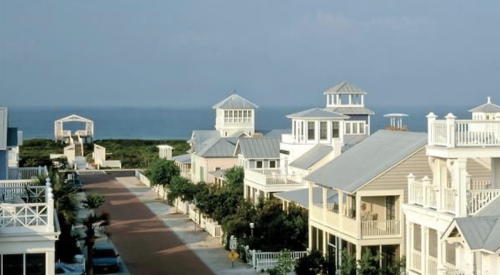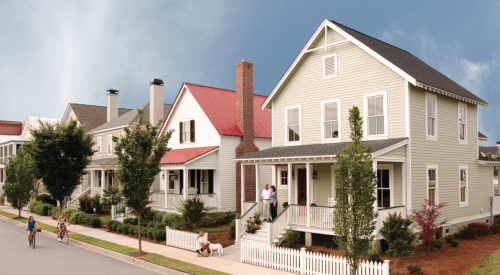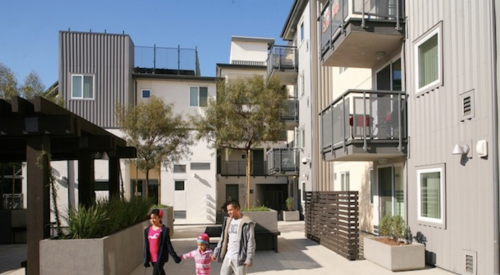Next door to Kentlands, a renowned example of traditional neighborhood development (TND) in Gaithersburg, Md., is Lakelands, which follows the same model. Lakelands is the best-selling community in Montgomery County today, partly because of the developers’ sensitivity to the needs of local residents.
Tom Natelli, president of Gaithersburg-based Natelli Communities, which is developing Lakelands with Classic Community Corp. of Bethesda, Md., says the 450-acre site had been owned by the National Geographic Society since the early 1960s. New homes sprang up all around it, but except for a single office building occupied by National Geographic, the land had not been developed.
In 1994, National Geographic decided to move to a less costly location and sold the property to Colony Capital, a West Coast real estate investment firm. It was zoned for 2 million square feet of office space but didn’t really make sense as a location for office development under then-current market conditions.
"After it was acquired, the city of Gaithersburg put the area into a moratorium to prevent any plan submissions until they got comfortable with what the new property owners planned for it," Natelli says. "They decided to update their master plan as part of any new initiatives for development."
Getting Involved
In the fall of 1995, Natelli Communities signed an agreement with Colony Capital to develop the site. Natelli thought the best way to plan the property was through the charrette process, which brings architects, land planners, builders, developers, legislators, code officials, neighborhood groups and other interested parties together. Charrettes are a proven method of building consensus for a project before it is submitted for approval.
"We recognized that we were going to be bringing quite a bit of change to this area and wanted to find out what was important to people who already live and work there," Natelli says.
Andres Duany of Miami-based Duany Plater-Zyberk architects and planners managed the charrette, which was held in March 1996 and lasted 11 days. "We invited hundreds of people — all the homeowners associations in the area, the Humane Society, the state department of natural resources, the state and local transportation departments, the parks and planning commission," Natelli says. "And we brought in about 30 planners from around the country. We literally had, at times, 300 or 400 people in some of these planning sessions and took a very open-book approach."
Inevitably, the charrette attracted people who didn’t want the site developed. "There were definitely those voices all along the way," Natelli says. "But the extreme positions didn’t carry a lot of weight because all those who were involved had a good understanding of why it made sense to support the plan as it was crafted in the process."
Jennifer Russel, director of planning and code for the city of Gaithersburg, says there was concern about the outparcels associated with Lakelands. However, because most of the people living adjacent to the property were from Kentlands, they embraced the neotraditional community concept wholeheartedly. "Lakelands and Kentlands are viewed as seamless communities," Russel says. "The developers are different, but they’re both focused on [creating] modern 19th-century towns with the best aspects of walkability, pedestrian orientation and sense of community and place."
The plan produced during the charrette was very similar to Kentlands and permitted up to 2,400 dwelling units with a mix of product types: apartments, condominiums, townhouses and single-family homes. Like Kentlands, it featured rear-loaded garages accessed by private alleys, narrow streets and homes set close to the sidewalks. The amenities included local parks, a site for a house of worship and a town center with a movie theater, an ice-skating rink and a coffee shop. About 125 acres were set aside for parks, lakes and trails.
Russel says Lakelands was intended to complete Kentlands in the sense that its retail area, Market Square, would have not only shopping but also dining and entertainment. In addition, the two communities are linked through pedestrian and bicycle trails.
After the charrette, the city updated its master plan and changed the zoning of the property from commercial to mixed-use. "Basically, it’s a TND zone in the city," Natelli says. This part of the process took a year to complete. Although the zoning permitted up to 2,400 homes, "we’re actually ending up with about 1,700. We probably have 500 or 600 apartments and condos, and the rest are split 50-50 between singles and townhouses of various types. We felt that was the right balance for the community. To get [a greater number of units], we were going to have to build a lot more multifamily, which we didn’t think would result in the mix of lifestyles we wanted to achieve."
In the spring of 1997, the developers submitted preliminary site plans. Groundbreaking started at the end of 1997. To date, 863 homes are sold and 253 apartments are rented.
Natelli says the city was instrumental in making Lakelands happen. "The mayor at the time, Ed Borher, who has since passed away, had been through the original charrette process for Kentlands and seen it developed. The whole city had become believers in not only that approach to planning, but the value of TND and the recognition that density, in and of itself, is not a bad thing if it’s done in a way that achieves great lifestyle."
In addition to DPZ, key players included EDAW in Alexandria, Va., a land- planning firm with offices all over the world, and John Carman of Rodgers & Associates, a Gaithersburg-based engineering firm. Carman "took two-dimensional concepts and turned them into a plan that could be achieved. You can draw all these pretty pictures, but making them come alive is a different thing."
While Natelli shepherded Lakelands through the charrette, rezoning and approval processes, Classic Community Corp. lined up home builders and formulated a marketing strategy.
Steve Eckert, Classic Community president, recently took over the day-to-day management of the project to let Natelli focus on other business matters. The builders at Lakelands include NVHomes, Ryland Homes, The Bozzuto Group and Ryan Homes. The developers also build homes (Natelli builds under the name Main Street Homes). Home prices range from $150,000 to $650,000.
Sales have been so strong that Eckert predicts the community will be sold out by 2003, a year ahead of projections.
Lakelands is a good example of what can be achieved when developers partner with the community and government, Natelli says. "I think it’s well-regarded and well-received, and you don’t see opposition in any kind of concentrated way."
According to Russel, the excitement of home buyers is palpable. "You get the feeling when you’re out there that they’re waiting on the curb for their house to be built," she says.
Rewriting the Rules of Suburbia: Lakelands, Gaithersburg, Md.
- Full Charrette Process: Before a formal proposal from developers, leading New Urbanist Andres Duany led an 11-day process of public input that was considered a big success. This commitment of resources is considered key to neutralizing neighborhood opponents.
- Comprehensive Plan Alterations: After the charrette, the city of Gaithersburg modified its comprehensive plan to allow traditional neighborhood development (TND) on the site. This process took one year, sped by the success of neighboring TND Kentlands.
- New Urbanism: Lakelands is designed and engineered under strict New Urbanist guidelines including narrow streets, some rental units over retail, rear garages, small lots and row houses. Designed to mesh well with neighboring TND community. while estate lots are as large as 35 acres. Previous zoning was one unit per 21/2 acres.
-
Also see:
Rewriting the Rules of Suburbia
City Moves UGB to Allow New Development
Integrating Old and New
Three Years, 200 Open Meetings, One Vision
Rewriting Land-Use Rules in Lancaster County: Balancing Framing and Growth













